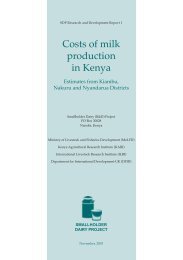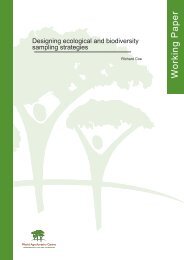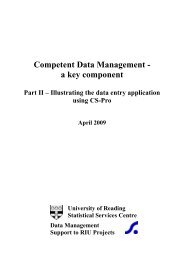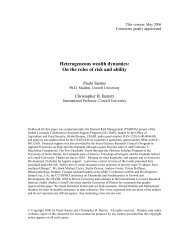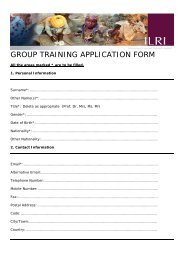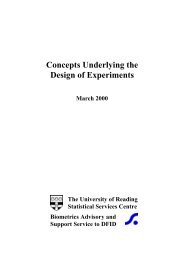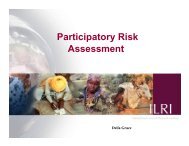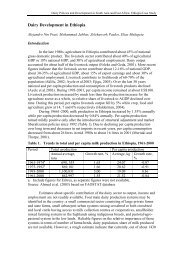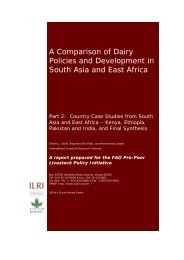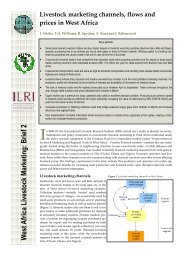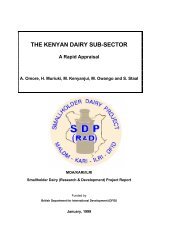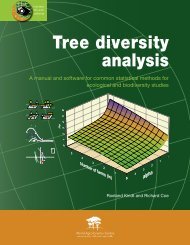Table 12. Cont<strong>in</strong>ued.SituationsMovements <strong>of</strong> animals across borders associated withspread <strong>of</strong> <strong>in</strong>fectious diseases.Socio-economics and policyRapid urbanisation and grow<strong>in</strong>g <strong>in</strong>comes.Increased demand for animal products.Self-sufficiency <strong>in</strong> dairy products low <strong>in</strong> mostcountries <strong>in</strong> the ASEAN.Meat consumption low.Favourable policies for <strong>in</strong>dustrialisation andcommercialisation <strong>of</strong> agriculture.Increased mechanisation and decrease <strong>of</strong> largerum<strong>in</strong>ants <strong>in</strong> irrigated areas.Increas<strong>in</strong>g commercialisation <strong>of</strong> agriculture and ris<strong>in</strong>gwage rates <strong>in</strong> irrigated areas.Integrated crop–animal systems more pr<strong>of</strong>itable <strong>in</strong>ra<strong>in</strong>fed areas due to lower opportunity cost <strong>of</strong>resources.Food security and poverty are major problems.Women play a significant role <strong>in</strong> animal managementat the farm level.Some credit available for improved technology use.Some <strong>in</strong>formation available on pr<strong>of</strong>itabletechnologies for crop–animal systems.Tra<strong>in</strong><strong>in</strong>g and <strong>in</strong>formation exchangeStronger <strong>in</strong> the ASEAN sub-region but weak <strong>in</strong> theMekong countries.Knowledge <strong>of</strong> farm<strong>in</strong>g systems research weak.Inadequate contact between scientists.Weak <strong>in</strong>formation exchange.Library facilities are poor and access to <strong>in</strong>formation isespecially weak <strong>in</strong> the Mekong countries.IssuesFew studies on helm<strong>in</strong>thiasis and helm<strong>in</strong>th resistance.Limited knowledge on the l<strong>in</strong>kages between structure<strong>of</strong> demand for animal products and response <strong>of</strong>production systems.Limited knowledge on impact <strong>of</strong> macro-economicand trade policies on smallholder production.No knowledge on impact <strong>of</strong> various constra<strong>in</strong>ts onloss <strong>of</strong> potential output.Inadequate knowledge <strong>of</strong> factors <strong>in</strong>fluenc<strong>in</strong>gtechnology adoption and evolution <strong>of</strong> systems.Information on l<strong>in</strong>kage between animals, foodsecurity and poverty alleviation non-existent.Little knowledge on structure and efficiency <strong>of</strong> <strong>in</strong>putand output market.L<strong>in</strong>kage between resource degradation and policyunclear.Lack <strong>of</strong> <strong>in</strong>formation on energy flows betweencrop–animal systems.Marketability <strong>of</strong> proposed technology <strong>in</strong>terventionsnot known.Improved regional policy for control <strong>of</strong> foot-andmouthdisease needed.Inadequate credit and unfavourable property rightsfor improved technology use.Tra<strong>in</strong><strong>in</strong>g on farm<strong>in</strong>g systems methodologies at severallevels urgently needed.Tra<strong>in</strong><strong>in</strong>g needed <strong>in</strong> selected areas, e.g. feed utilisationand socio-economics.Need for network<strong>in</strong>g arrangements to l<strong>in</strong>k <strong>in</strong>stitutionsand scientists.Need to improve <strong>in</strong>formation access and exchange.It should be emphasised that these key researchable issues are not arranged <strong>in</strong> any order <strong>of</strong> importance.The situational analyses have been used for ex ante analysis and priority-sett<strong>in</strong>g <strong>in</strong> the follow<strong>in</strong>g chapter, andalso allude to the conclusions and recommendations <strong>in</strong> Chapter 7.ConclusionsThe situational analysis on the two target AEZs and the production systems has enabled a sharper focus onthe key researchable issues <strong>in</strong> four ma<strong>in</strong> areas: feed resources and rum<strong>in</strong>ant nutrition, animal geneticresources, animal health and diseases, and socio-economics and policy. Tra<strong>in</strong><strong>in</strong>g and <strong>in</strong>formation exchangewas also emphasised. Additionally, livestock and environment (to encompass natural resource managementissues) and systems analysis were <strong>in</strong>cluded as researchable areas. This analysis further enabled the next task<strong>in</strong> priority-sett<strong>in</strong>g for research and tra<strong>in</strong><strong>in</strong>g <strong>in</strong> South-East Asia to be completed.
6. Strategy for researchJustification for researchThe strategy for research to improve livestock <strong>in</strong> crop–animal systems <strong>in</strong> the lowlands and uplands <strong>of</strong> South-EastAsia builds on the detailed <strong>in</strong>formation presented <strong>in</strong> the previous chapters. The pr<strong>in</strong>cipal arguments for <strong>in</strong>creasedresource allocation for research on crop–animal systems <strong>in</strong> the lowlands and uplands are as follows:1. The focus <strong>of</strong> crop production has been on the over-populated irrigated areas which are already used<strong>in</strong>tensively. To further <strong>in</strong>crease crop production emphasis needs to be given to the neglected lowlandand upland AEZs. In this context, advantage can be taken <strong>of</strong> the significant populations <strong>of</strong> animals onmixed farms to enhance the susta<strong>in</strong>ability <strong>of</strong> the food crop systems.2. Fifty-one per cent <strong>of</strong> the cattle and 55% <strong>of</strong> the small rum<strong>in</strong>ant populations <strong>in</strong> Asia are found <strong>in</strong> thetarget AEZs. The need to <strong>in</strong>crease productivity is highlighted by the fact that the South-East Asianregion as a whole has a deficit <strong>in</strong> animal prote<strong>in</strong> supplies, notably beef, milk, goat meat and mutton.Most governments <strong>in</strong> the region, therefore, have given priority to the development <strong>of</strong> rum<strong>in</strong>antproduction.3. Ris<strong>in</strong>g populations, higher <strong>in</strong>comes, urbanisation and chang<strong>in</strong>g consumer preferences will fuel an<strong>in</strong>creased demand for animal products. The current urban demand is met ma<strong>in</strong>ly by the commercialpig and poultry <strong>in</strong>dustries, but the smallholder mixed farm<strong>in</strong>g systems, where over 95% <strong>of</strong> animals arefound, will be expected <strong>in</strong> the future to <strong>in</strong>crease supplies, pr<strong>in</strong>cipally from <strong>in</strong>tensification andspecialisation.4. The ra<strong>in</strong>fed AEZs are vulnerable to resource degradation, particularly <strong>in</strong> the uplands where there arelarge numbers <strong>of</strong> resource-poor farmers practis<strong>in</strong>g shift<strong>in</strong>g cultivation. There is widespread povertyand concerns <strong>of</strong> equity and the environment. <strong>Animal</strong>s are <strong>of</strong>ten the ma<strong>in</strong> means for <strong>in</strong>come generation(e.g. <strong>in</strong> the Lao PDR and Cambodia 45–56% <strong>of</strong> total farm <strong>in</strong>come) and the improvement <strong>of</strong> livelihoods.Increased resource allocation for research on crop–animal systems <strong>in</strong> the two target AEZs is clearlynecessary <strong>in</strong> the context <strong>of</strong> the need for more food, greater equity and also environmental considerations.Guid<strong>in</strong>g pr<strong>in</strong>ciplesIt is appropriate to keep <strong>in</strong> perspective the guid<strong>in</strong>g pr<strong>in</strong>ciples for research to improve animal production <strong>in</strong>mixed farm<strong>in</strong>g systems <strong>in</strong> the two AEZs. These pr<strong>in</strong>ciples <strong>in</strong>clude:• A clear def<strong>in</strong>ition <strong>of</strong> priorities with<strong>in</strong> production systems, species and commodities.• Research must be problem-solv<strong>in</strong>g, and must have application and fuel development.• Research and development programmes should address major constra<strong>in</strong>ts, real needs, and generate newknowledge and products. The programmes need to ensure technology delivery to clients, e.g. NARSand farmers, and <strong>in</strong>clude tra<strong>in</strong><strong>in</strong>g opportunities.• Institutional commitment to demand-led research that is multidiscipl<strong>in</strong>ary and systems-orientated.• The comparative advantage for research <strong>of</strong> <strong>in</strong>dividual public and private sector organisations must berecognised and strong l<strong>in</strong>kages promoted. The development process can also be enhanced significantlyby promot<strong>in</strong>g symbiotic relationships with the private sector, extension services, the NGOs andcommunity organisations. Active partnerships between NARS and these groups, with ILRI act<strong>in</strong>g asfacilitator, can extend impact.• Research programmes must acknowledge current concerns on poverty alleviation, food security,environment, equity, gender and susta<strong>in</strong>ability.
- Page 2 and 3: Affiliation of Authors:Dr C. Devend
- Page 4 and 5: 6.Strategyfor researchJustification
- Page 7 and 8: AcknowledgementsThe International L
- Page 9 and 10: esearch opportunities appropriate t
- Page 11 and 12: Table 1.Animal populations and meat
- Page 13 and 14: Introduction2. Characterisation and
- Page 15 and 16: Figure 2. Sub-humid tropics and sub
- Page 17 and 18: Table 3.Human and animal population
- Page 19 and 20: Table 5. Rice-growing environments
- Page 21 and 22: Multiple upland annual crop systems
- Page 23 and 24: Table 6. Continued.Country Importan
- Page 25 and 26: It should be noted that, compared w
- Page 27 and 28: Table 8.CountryCambodiaChinaIndones
- Page 29 and 30: of non-renewable fossil fuels and t
- Page 31 and 32: Overview of researchThere was a sur
- Page 33 and 34: • Identification of alternative c
- Page 35 and 36: Various animal production systems t
- Page 37 and 38: Presently, much of the vegetable pr
- Page 39 and 40: Table 10. Summary of the main socio
- Page 41 and 42: Table 11. Institutions and organisa
- Page 43 and 44: 3. In the ASEAN sub-region, inadequ
- Page 45: Table 12. Continued.SituationsPract
- Page 49 and 50: Table 13. Priorities for research a
- Page 51 and 52: VietnamResearch capacity in NARS is
- Page 53 and 54: CRIFC (Central Research Institute f
- Page 55 and 56: IAS. 1995. Proceedings of the Works
- Page 57 and 58: Systems of sub-Saharan Africa. Volu
- Page 59 and 60: or waterlogged in the wet season an
- Page 61 and 62: Table A1. Important diseases of ani
- Page 63 and 64: • Increased cropping intensities,
- Page 65 and 66: the animal output came from pigs al
- Page 67 and 68: 18-21° North, with an average rain
- Page 69 and 70: In the Nusa Tenggara islands, signi
- Page 71 and 72: Women work 11.5 h/day on average co
- Page 73 and 74: Various Australian forage projects
- Page 75 and 76: village production systems; to stud
- Page 77 and 78: The availability of feed in rubber
- Page 79 and 80: of the Ayeyarwady and Sittang river
- Page 81 and 82: Constraints and opportunitiesInadeq
- Page 83 and 84: gaining in importance, and signific
- Page 85 and 86: Table A3. Characterisation of crop-
- Page 87 and 88: Table A4. Interventions in crop-ani
- Page 89 and 90: Table A4. Continued.Project TitleGo
- Page 91 and 92: otations are practised, and there a
- Page 93 and 94: such as abortion. Vaccination cover
- Page 95 and 96: large areas of forests (3.4 million
- Page 97 and 98:
Table A6. Some animal diseases repo
- Page 99 and 100:
Appendix IIItineraryThe Philippines
- Page 101 and 102:
26 November 1996 am Visit to small
- Page 103 and 104:
Appendix IIIList of persons metPhil
- Page 105 and 106:
Mr Chhiv Nan, Acting Director, Depa
- Page 107 and 108:
Dr U Maung Ngint, Managing Director
- Page 109:
List of acronymsAARDACIARADBAEZAIBP



